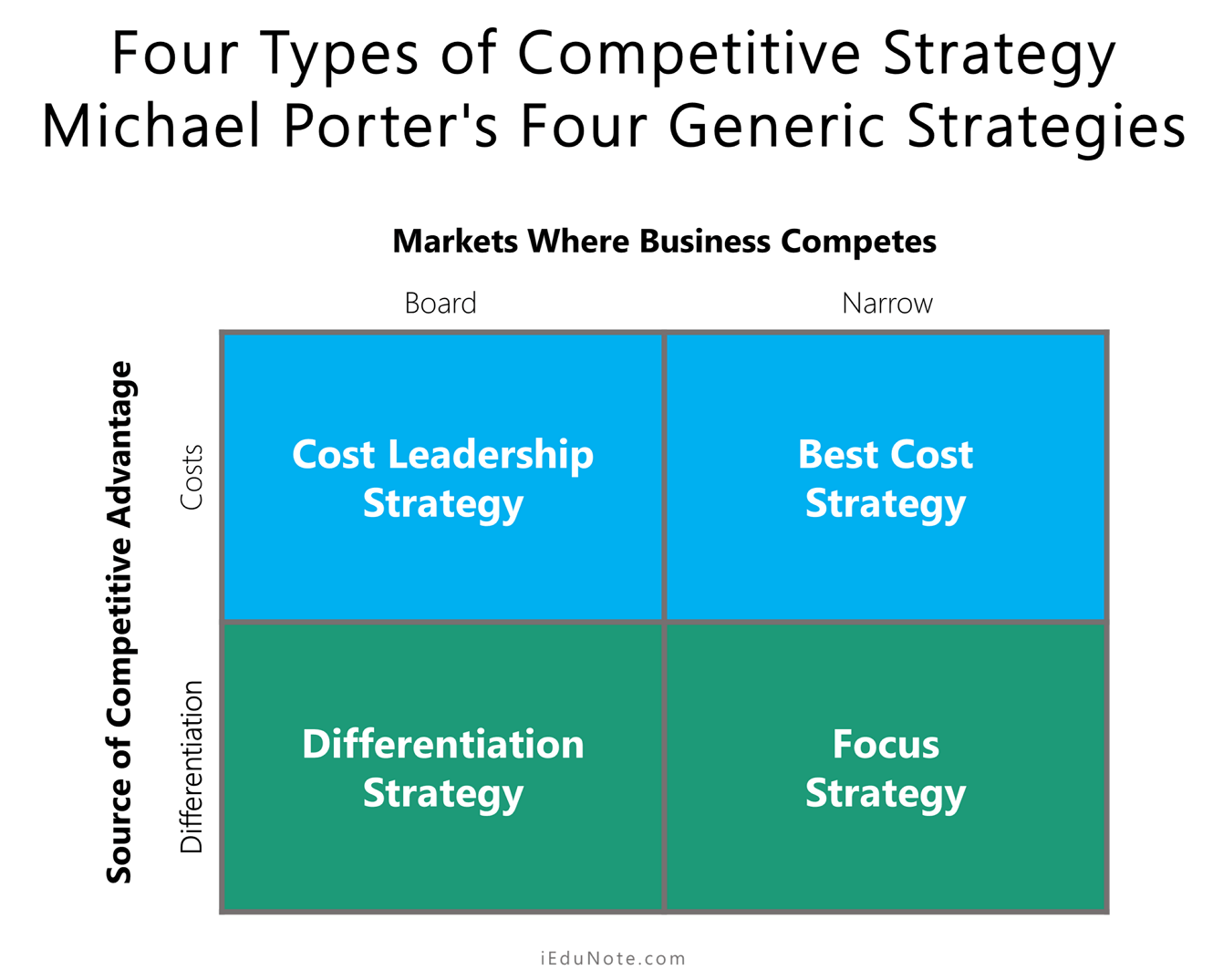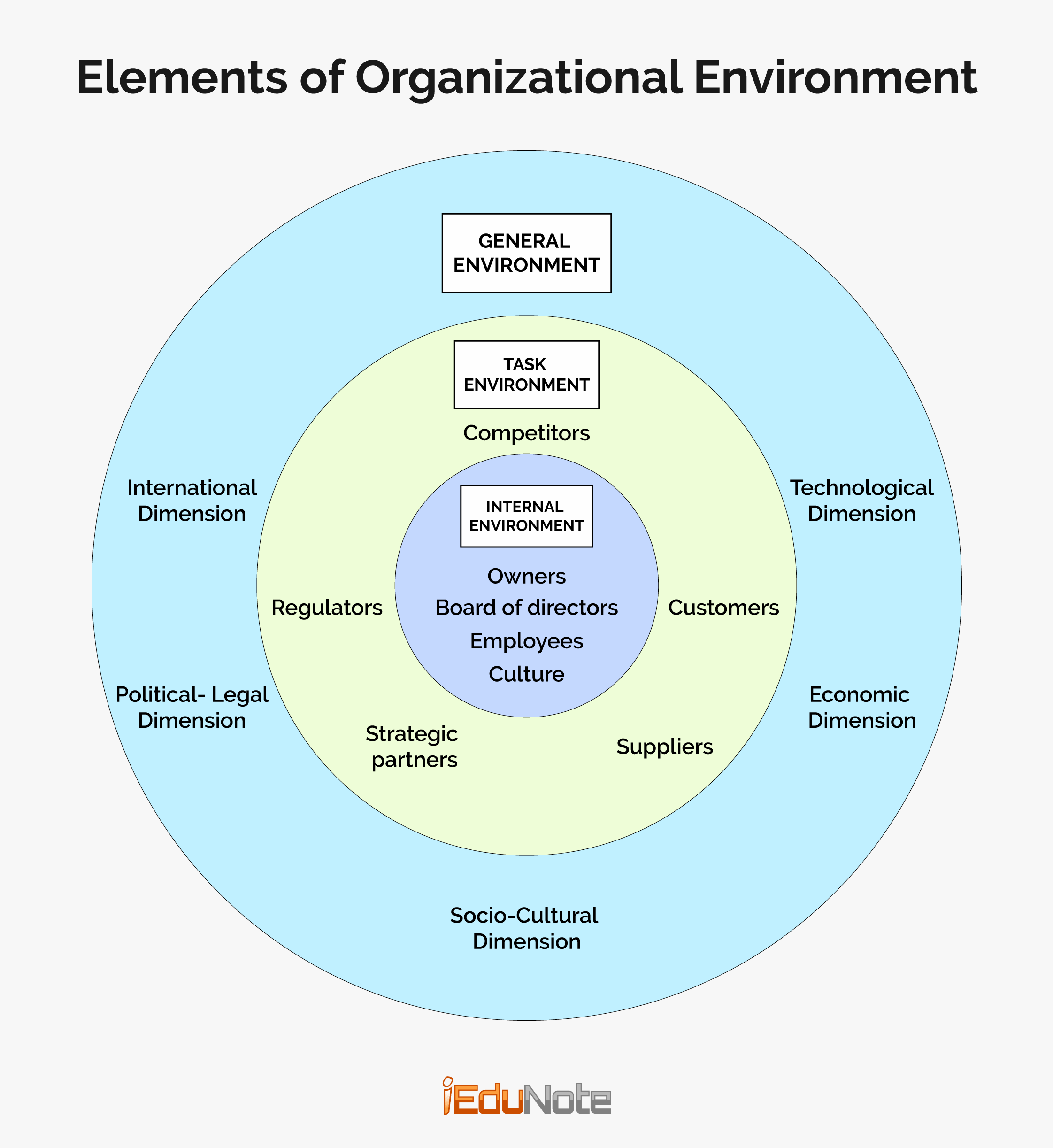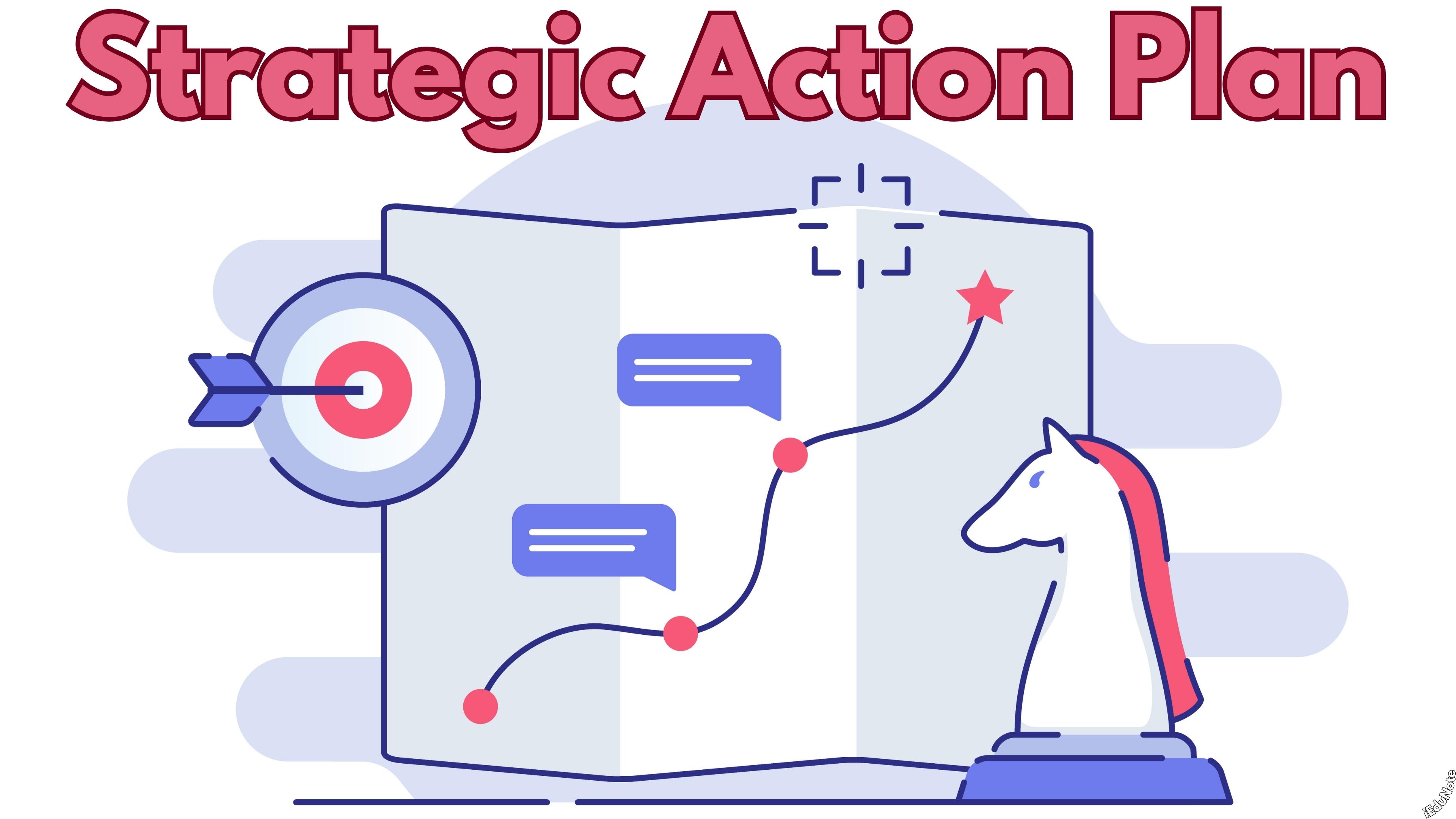Explore four types of competitive strategies: cost leadership, differentiation, best-cost, and market niche. Achieve sustainable advantage and superior value.
The competitive strategy consists of the business approaches and initiatives undertaken by a company to attract customers and deliver superior value through fulfilling its expectations and strengthening its market position.
This definition by Thompson and Strickland emphasizes the ‘approaches and initiatives’ of managers in defining strategy. This means that competitive strategy concerns managers’ actions to improve the company’s market position by satisfying the customers.
Improving market position implies undertaking actions against competitors in the industry.
What is Competitive Strategy?
The concept of competitive strategy (as opposed to cooperative strategy) has a competitor orientation. The competitive strategy includes those approaches that prescribe various ways to build sustainable competitive advantage.
Management’s action plan is the focus of the competitive strategy. Management adopts an action plan to compete successfully with the competitors in the market. It also aims at providing superior value to customers.
The objective of competitive strategy is to win the customers’ hearts by satisfying their needs and finally to attain competitive advantage as well as out-compete the competitors (or rival companies.).
Competitive advantage is the special edge that allows an organization to deal with market and environmental forces better than its competitors.
It is derived from strategies that lead to some uniqueness in the marketplace. It indicates a company’s competitive position that allows it to achieve higher profitability than the industry average.
To develop a competitive advantage, a company should develop distinctive competencies. Distinctive competencies come from unique resources and capabilities that organizations use to build a competitive position.
The Generic Building Blocks of Competitive Advantage
Competitive advantage depends on four core building blocks that any company can adopt regardless of its industry or the products or services it produces:
Efficiency
Superior efficiency enables a company to lower its costs. The basic form of measuring efficiency is the quantity of inputs it takes to produce a given output. An efficient company can produce a given output by using minimum inputs.
Quality
As a building block of competitive advantage, superior quality allows for both premium prices and lower costs.
Many companies’ emphasis on quality shows that achieving high product quality can no longer be viewed as just one way of gaining a competitive advantage. In many industries, it has become an absolute imperative for survival.
Innovation
These days, innovation has no alternative. Organizations view innovation as a strong strategic tool. Superior innovation helps a firm to ask for premium prices. This is perhaps the single most important building block of competitive advantage. Uniqueness allows a firm to protect itself from its rivals for a long time.
Customer Responsiveness
Customer responsiveness allows a firm to satisfy the needs and demands of the customer more competitively than its rivals. It means consistently developing such competencies in products and services that competitors lack.
Achieving superior quality and innovation is an integral part of achieving superior customer responsiveness. Continuous focus on these building blocks helps an organization get a sustained competitive advantage.
Sources of Competitive Advantages
A company can achieve a competitive advantage when it is able to use its resources and capabilities successfully to create more value than competitors in attracting customers and defending against competitive forces. There are many sources of competitive advantages:
- Having the most excellent product on the market.
- Delivering superior customer service.
- Providing products at a lower cost than the competitors.
- Products with more appealing features and style.
- Shorter lead times in developing and delivering products to customers.
- Brand creation and reputation.
- Creating more value for customers.
As a low-cost leader and differentiator, an organization can sustain its competitive advantage for a long time period. Michael Porter has argued that low cost and differentiation are two basic strategies for creating value and attaining a competitive advantage in an industry.
Four Types of Competitive Strategy: Michael Porter’s Four Generic Strategies
Michael Porter has identified four types of competitive strategies that can be applied in any business organization irrespective of the size and nature of products. Because of their susceptibility to common use by all business enterprises, they are labeled as generic strategies.
These are, in fact, basic types of competitive strategies.
In addition to these, there are also other strategies that a company can employ when deemed necessary, such as strategic alliance, collaborative partnerships, mergers, acquisitions, vertical integration, outsourcing strategies, etc.

4 competitive strategies are as follows:
- Cost Leadership Strategy or Low-cost strategy.
- Differentiation strategy.
- Best-cost strategy.
- Market niche or focus strategy.
Competitive Advantage: Ultimate Goal of Competitive Strategy
Competitive advantage is the special edge over the competitors. Managers often ask a question: “What is the duration of competitive advantage?”
How long it will be sustained primarily depends on the following;
- barriers to imitation,
- the capability of competitors and
- the general dynamism of an industry’s environment.
‘Barriers to imitation’ create obstacles for competitors to copy a company’s distinctive competencies easily. Competitors will always try to imitate a company’s resources and capabilities.
Evidence indicates that capabilities are more difficult to imitate than resources.
Of the resources, tangible resources (e.g., plant and machinery equipment, buildings) are easier to imitate than intangible resources (e.g., patents, goodwill, brand names, technological know-how, marketing techniques).
Thus, there is a need to build distinctive competence based on unique capabilities rather than tangible resources. This would help the company enjoy distinctive competence for a longer period.
The capability of competitors to imitate a company’s distinctive competency needs to be considered.
If the competitors are strongly committed to doing business in a particular way, they will not suddenly imitate a company’s innovation.
In such a situation, its distinctive competency will be sustainable for longer.
The third factor of sustainability of distinctive competency – industry dynamism – is also an important determinant of competitive advantages.
Frequent product innovation makes an industry environment dynamic.
For example, the software industry, electronics industry, and PC industry are highly dynamic because of the high rate of innovation. In such industries, competitive advantages are short-lived.
Types of Major Competitive Scopes
Industry Scope
A company may decide to operate in only one industry or in a number of industries. Yet there are other companies that may be willing to operate in any industry.
Products and Applications Scope
It tells us about the range of products and applications that a company may supply. For example, an optical items manufacturing company may decide to produce an entire range of optical products and supply them worldwide.
Competence Scope
It tells us basically the strengths of the company. A company may have strengths(competencies) in areas using which it may produce a couple of items efficiently. Microsoft company of the US could be taken as an example producing computer software of entire range.
Market-Segment Scope
A company may decide to operate in a selected customer type or market segment. The market-segment scope gives an idea about the segment/s a company is willing to serve. For example, Kohinoor Chemical Company Limited aims its cosmetics products at lower and lower-middle-class segments.
Vertical Scope
It tells us about the number of channel levels in which a company participates in procuring raw materials to distribute final products.
This scope varies from company to company. In some instances, companies may have a large vertical scope, i.e., integration of different levels of operation, and in other instances, there may be no vertical integration.
Geographical Scope
Shall a company operate within its national boundary or extend operations beyond it? The answer may be known by its geographic scope.
A company’s mission statement should take a long-term perspective. It should provide long-term direction to the company’s operation. Mission statements, therefore, cannot be changed frequently. Companies should be very careful in defining missions and redefining them if required.
How do we sustain a competitive advantage?
Since achieving and maintaining a competitive advantage is the primary aim of competitive strategies, managers should undertake measures to sustain competitive advantage once they are achieved.
6 ways managers can build sustainable competitive advantage;
- Focusing on building blocks of competitive advantages
- Developing distinctive competencies
- Creating an environment of organizational learning
- Instituting continuous improvement mechanism
- Instituting best practices
- Overcoming barriers to change
Focusing on building blocks of competitive advantages
As stated earlier, a company has a sustained competitive advantage when it can maintain a higher-than-industry average profit rate over several years.
This becomes possible when the company emphasizes the four generic building blocks of competitive advantages, such;
- efficiency,
- quality,
- innovation, and
- customer responsiveness.
Because of its focus on these building blocks, Apple Computer Company enjoyed a sustained competitive advantage over a long period from 1987 to 1993.
These are called ‘generic’ because any organization can adopt them irrespective of its products (or the industry in which it operates its business).
Superior efficiency enables a company to lower its costs; superior quality allows it both to lower costs and charges a higher price; superior customer responsiveness allows it to charge a higher price, and superior innovation can lead to higher prices or lower unit costs.
Together these four building blocks help a company create more value than its competitors.
Thus, a company can enjoy a sustained competitive advantage.
Developing distinctive competencies
Managers have to develop distinctive competencies to sustain a competitive advantage.
When distinctive competencies are developed, they help in improving performance in all the areas of four building blocks.
Distinctive competencies should be developed in all required areas – never in some areas at the cost of other important areas. Companies need to be balanced in their pursuit of distinctive competencies.
Creating an environment of organizational learning
Sustaining competitive advantage requires a congenial environment in the organization that promotes learning within the organization (commonly known as organization learning).
Learning organizations can keep themselves at the top of all competitors because they are always in search of knowledge.
In the process of seeking and disseminating knowledge, they learn from prior mistakes and improve their work-processes over time.
Instituting a continuous improvement mechanism
Continuous improvement of the quality of both products and services (in fact, of everything that a company does) in sine qua non for sustaining competitive advantage over a longer period.
Managers need to devise dynamic ways to improve quality continuously.
Some organizations have succeeded in improving quality through instituting total quality management (TQM) programs and business process reengineering.
Instituting best practices
The adoption of ‘industrial best practices’ helps develop distinctive competencies and thereby sustain competitive advantage.
Organizations can benchmark (search out) the successful business practices of other competitors/companies in other industries and then adopt them after necessary fine-tuning.
Thus, they can build and maintain resources and capabilities – that are essential to achieve excellence in efficiency, quality, innovation, and customer responsiveness.
Overcoming barriers to change
Companies fail to sustain a competitive advantage because they cannot adapt to organizational changes.
They need to overcome the resistance to change so that they can maintain a competitive advantage.
Companies can overcome the barriers to change by providing effective leadership, necessary changes in organization structure, creating appropriate control systems, and involving employees in decision-making.
Distinctive Competency: An Essential Requirement for Achieving Competitive Advantage
To be competitive in the marketplace, a business organization must have distinctive competency in one or more areas of its activities.
Distinctive competencies refer to those strengths of the organization that allow it to attain a competitive advantage in the market.
These strengths are unique for the organization and they help it achieve superior efficiency, quality, innovation, and customer responsiveness.
It can be argued that PepsiCo has distinctive competencies in the case of manufacturing bottled drinking water – Aquafina.
Distinctive competencies have helped PepsiCo achieve lower costs and make product differentiation better than its competitors.
Thus, distinctive competencies have helped attain distinctive advantages through the achievement of superior efficiency and quality.
Unique organizational resources and capabilities constitute an organization’s distinctive competencies.
However, the organization’s resources must be unique (i.e., no other companies have these resources) to be regarded as distinctive competencies. The resources are physical, human, financial, informational, and technological.
An organization’s capabilities are the skills necessary to exploit the resources for productive use. Capabilities are intangible.
It may be noted that an organization may not need unique resources to establish a distinctive competence as long as no other competitors possess such resources. An organization can create distinctive competencies only when it simultaneously has unique resources and can use them effectively.
Successful strategies often either build on a company’s existing competitive competencies or help a company develop new ones.
Competitive Strategy Versus Business Strategy
A business strategy has a wider scope than a competitive strategy. The business strategy encompasses all the actions and approaches for competing against the competitors and the ways management addresses various strategic issues.
As Hill and Jones have remarked, the business strategy consists of plans of action that strategic managers adopt to use a company’s resources and distinctive competencies to gain a competitive advantage over its rivals in a market.
In doing business, companies confront a lot of strategic issues. Management has to address all these issues effectively to survive in the marketplace.
Business strategy deals with these issues and ‘how to compete.’ On the other hand, the competitive strategy deals with “management’s action plan for competing successfully and providing superior value to customers.”
Conclusion
Attractive business strategies are grounded in sustainable competitive advantage. There are many paths to competitive advantage, but the most fundamental issue is to provide buyers with what they recognize as superior value.
Value can be created through a good-quality product with a low price, a superior product that is worth paying more for, or a best-value offering that represents an attractive combination of price, features, quality, service, and other attributes buyers find appealing.
The quality goals cannot be simply tacked onto strategic and operational plans. It must be a central aspect of the plans, or there’s a risk of being seen as less important than other goals, such as financial goals, growth goals, or productivity goals.
Competitive advantage is the special edge that allows an organization to deal with market and environmental forces better than its competitors.
It is derived from strategies that lead to some uniqueness in the marketplace. It indicates a company’s competitive position that allows it to achieve higher profitability than the industry’s average.
As a low-cost leader and differentiator, an organization can sustain its competitive advantage for a long time period. Michael Porter has argued that low cost and differentiation are two basic strategies for creating value and attaining a competitive advantage in an industry.
A low-cost provider always intends to satisfy its customers by offering products at a lower price than the competitors. They place emphasis on the production of standardized products at a low per-unit cost for price-sensitive customers.
Charging a lower price becomes possible when the company can ensure cost reduction by operating the business cost-effectively. The strategic target of this strategy is to serve the wide market based on price. Under this strategy, the company emphasizes cost reduction without reducing quality.
Differentiation is the act of designing a set of meaningful differences to distinguish the company’s offerings.
It is concerned with product differentiation as well as service differentiation. Differentiation strategy achieves a competitive advantage by creating a product (good or service) that is perceived by customers to be unique in some important way.
Differentiation safeguards a company against competitors to the degree that customers develop brand loyalty for its products.
Quality products are goods and services that are reliable in the sense that they do the job they were designed for and do it well. These days, organizations are largely focusing on quality issues. They believe that quality can best work as a differentiation strategy.
Providing high-quality products increases their value in the eyes of the customer. The impact of high quality on competitive advantage comes from the greater efficiency and the lower unit costs it brings.
Organizations have realized that survival is only possible through customer satisfaction, and satisfaction will come through quality goods and services at the lowest possible price.
The emergence of quality as a top priority in many corporate entities is primarily clear due to the globalization of world trade and the competitive pressure brought about by the escalating demands of consumers who want better products and services.
TQM is believed to be one of the essentials in revitalizing a company’s competitive position and has drawn the attention of manufacturing leaders all over the world. Many researchers, in one way or another, have argued that it has positive effects on employee satisfaction, product quality, customer satisfaction, and strategic business performance.

